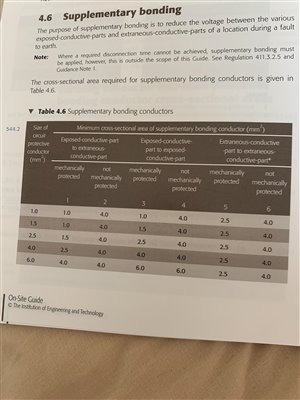MrJack96:
Thank you Andy. I’ve seen SWA daisy chained with earth links and then using a fly lead of one of them to connect all the armours to the chassis would it be better running individually fly leads to the chassis with the relevant sizes bonding?
Either individual leads for each gland, or one lead looped or daisy-chained to several glands, are both acceptable in principle.
In case of the daisy-chain, the fly lead would have to be sized according to the most onerous c.p.c. requirement - so if you had a mix of small and large cables, it might be easier to have separate leads rather than trying to loop a large conductor onto small glands. Or you might group all the small cables together and have a small fly lead for them, and likewise group all the large cables together, or even link a small gland to a large one with a thin fly lead and the large on to the chassis with a thicker flylead - the possibilities are almost endless.
If it was the kind of situation where there are likely to be lot of future alterations or modifications, having separate flyleads might make life easier as one cable could then be altered or removed without having to interfere with the connections to others; on the other hand if you had lots of cables terminating but a limited facility to connect to the chassis, then daisy-chaining might be far more sensible.
If you were confident of the connection between gland and gland-plate, but not of the screws that held the gland-plate to the chassis, you might have only one fly-lead for the entire plate.
Note that the connections to cable armours are normally a matter of earthing (connecting to a c.p.c.), rather than bonding. Strictly speaking only extraneous-conductive-parts (e.g. water or gas pipes) are bonded. That's significant because the minimum required sizes of c.p.c.s and bonding conductors (including fly-leads) have to be calculated in quite different ways. It's unlikely that any single size (e.g. 6mm²) will be suitable in all cases. Occasionally you might find that c.p.c. is also used as a bonding conductor (say the cable feeds a remote DB where main bonding connections are taken from) - in which case the sizes would have to be large enough to satisfy both the earthing and bonding requirements.
- Andy.

Paul Skyrme:
Potentially if this is feeding a motor of a machine then BS 7671 is irrelevant. (110.2,xi)
If this is on a VSD, then the SWA will be probably useless as a screen.
Most we have tested are worse than un-screened.
Many drive OEM's forbid SWA to the motor for this very reason.
I'm interested by this. Are the tests comparing unscreened cable (with one core for earthing) with a similar length of SWA where both ends are bonded to metallic enclosures in the thorough way that Graham mentioned? What does the test measure? Do OEMs recommend e.g. a tightly-woven screen instead, to avoid the thin gaps between armour wires?
Why’s it not classed as bonding sorry I’m just confused. I know if I used the armour as a cpc it would be earthing
MrJack96:
Thanks guys. So there is a requirement on sizing the earth links to the required size to carry fault current. As I’ve only really seen armoured coming into the gland plate and it’s mostly always daisy chained with 6mm2 cable. I don’t know if there’s any tables I can use. Thanks again guys.
Odd terminology again ("earth links") but see 543.1.1
We're about to take you to the IET registration website. Don't worry though, you'll be sent straight back to the community after completing the registration.
Continue to the IET registration site